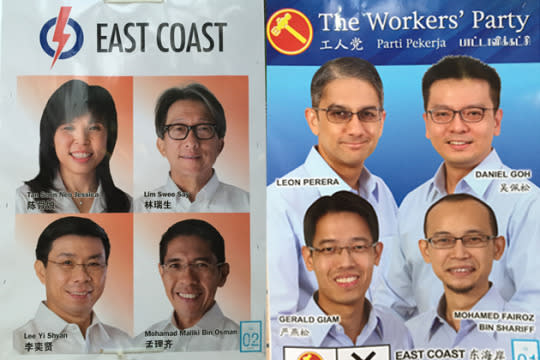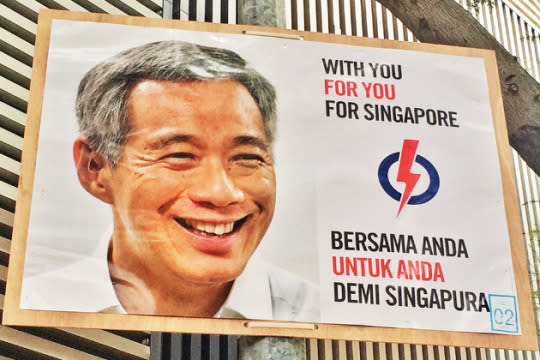GE2015: Reaching out to the electorate
Are campaign slogans just hyperbole, crafted just to elicit cheers from supporters at the hustings?
By Zul Othman

Above: East Coast GRC candidates in Simei. Both PAP and WP have crafted examples of good slogans that speak directly to the voter, said political watcher Eugene Tan.
You see them on posters everywhere as campaigning gets under way ahead of the 11 Sep General Election.
If nothing else, these carefully crafted slogans are aimed at rousing and reaching out to the voting masses.
But do these slogans really resonate with the voters?
The ruling People’s Action Party (PAP), for instance, believes its slogan will touch a chord with Singaporeans. The party has put out posters with the tagline “With you, for you, for Singapore” as its campaign slogan.
At the unveiling of the slogan on Aug 29, Prime Minister Lee Hsien Loong - who is also the PAP’s Secretary-General - said their slogan “tells of what we have achieved together, it tells you what we are doing together, it sets out the challenges we are facing together, and it points to what more we can build together”.
The Workers’ Party (WP) – which will be contesting 28 seats this year – has said that its campaign theme this year is “Empower your future”. Another opposition party, Singaporeans First Party, has issued its rallying cry “Restore our nation”.

Above: The People’s Action Party slogan for this year’s general elections.
“Helpful”
These slogans are not just hyperbole, crafted just to elicit cheers from supporters at the hustings either.
Gillian Koh, senior research fellow at the Institute of Policy Studies, told Yahoo Singapore that such slogans are “helpful” for voters “because they are a quick way to remember what the party stands for and helpful as part of the oratory at the rallies.”
Some opposition parties, however, are crafting more than just campaign slogans, in a bid to strike a chord with voters. The National Solidarity Party (NSP), for example, has put up posters with taglines like “Is CPF personal life savings your money?” in Tampines GRC, where they are contesting.
Meanwhile, Pasir Ris-Punggol contenders Singapore Democratic Alliance (SDA) has campaign posters that say, “Say no to 6.9”, a reference to the controversial Government Population White Paper from 2013, which forecast the Singapore might be heading towards a population of 6.9 million.
Tampines GRC resident Vincent Lim, who has seen the NSP posters in his neighbourhood, was unconvinced the party’s presence in Parliament would change things.
“It is a good point to highlight but what I need to know is, can their candidates change the policy if elected,” said the 50-year-old, who works in the aviation industry.
“You can come up with the best slogans and catchy facts, but what voters also want to know are alternatives – something I’ve yet to see from all the political parties,” added Pasir Ris-Punggol resident Mohd Azim Rahim, a retiree.

Above: A National Solidarity Party poster in Tampines.
What makes a good political slogan?
So therein lies the ultimate question: Can party slogans be more than just a rallying war cry?
Or what we really need is a catchy catchphrase to rouse the political apathetic Singaporean?
Veteran political observer Wong Wee Nam told Yahoo Singapore, “I don’t think a lot of people pay any attention to the slogans… I think most voters will be listening what these candidates say at the rallies (before making up their minds).”
Singapore Management University (SMU) Associate Professor of Law Eugene Tan agreed.
But rather than be witty or numb the electorate with facts, perhaps what is needed is an effort to match the slogans with the public’s understanding of the party’s policies.
Tan said: “Voters have a very limited bandwidth so parties that are smaller in nature need slogans that resonate with the people.”
The slogans of the PAP and WP – rival parties with competing agendas – are notable examples, said the academic.
“The ruling party’s slogan is seeking to leverage on the SG50 wave, reminding Singaporeans of the PAP’s track record and the fact that even when the policies were unpopular, they were intended for Singapore’s benefit,” explained Tan, a former Nominated Member of Parliament.
“As for the WP slogan, it seeks puts the voter at the centre of the election. Both the PAP and WP slogans also are “voter-centric” because both parties realise the need to reach out to the electorate,” he added.
This fact is not lost on an East Coast GRC resident, who wanted to be known only as Hisham.
“I live in Simei, an area contested by the PAP and WP,” the 39-year-old logistics officer told Yahoo Singapore.
“Both sides are interested in the resident’s well being. That’s a good sign because what I am concerned about is the future and how it will affect my children,” he added.
More than two million Singaporeans will be voting this GE to choose 89 MPs in 16 Group Representation Constituencies (GRCs) and 13 Single-Member Constituencies (SMCs).
In the last general election, the PAP won 81 of the 87 seats. It also pulled in 60.1 per cent of the national vote, down from the 66.6 per cent at the 2006 general election.

